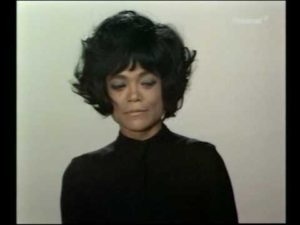- A Survivor’s Prayer: A Review of Ordinary Beast by Nicole Sealey

- Adler Guerrier: Deployed, Conditional, and Limited Utopia
The Black Aesthetic at the Living Room Light Exchange

The Black Aesthetic, an Oakland-based arts organization, has declared its mission to “curate and assemble both a collective and distinct understanding of Black visual culture.” On September 19, as part of a presentation for the Living Room Light Exchange, an organization showcasing Bay area digital media artists, Ryanaustin Dennis and Leila Weefur, members of the Black Aesthetic, work towards this mission. Their multimedia presentation includes “Three N****** in a Woodpile,” which employs clips from classic films, and an original film, “What is the Black Aesthetic?” and poses questions about Blackness.
The most startling moment occurs when an image of Eartha Kitt, teary-eyed and wearing a dark turtleneck, smashes through the screen. Kitt sings dramatically; her voice, traveling a distance of more than fifty years, sounds as if it’s about to break. In response, the audience makes a collective gasp of nervousness or amusement. I’m not sure which. Kitt, a mixed-raced Black woman who spent her childhood in South Carolina, never knew the identity of her white father, and her pain feels real: watching her, we’re confronted with the power of representation, of Kitt and generations of Black people not seeing themselves, even as what exactly blackness is, how we delineate it, remains muddy. This seems to be the point of the presentation.
Kitt performed Black Little Angels (based on the poem by Andres Eloy Blanco, music by Manuel Alvarez Maciste) in 1953, but the song has also been recorded by North Carolina-born singer Roberta Flack in 1969, and Falana, the Nigerian-Canadian singer, in 2015. These different renditions of the song reveal how our concepts of Blackness change over time. The problematic 1948 Mexican film, Angelitos Negros, summarized by IMDB as “story of…a woman who does not realize her heritage, brought up as the ‘white’ wealthy patron’s daughter… is actually the daughter of the black maid,” reveals these changing conceptualizations. Blanco’s poem concerns a painter who wishes to paint Black angels to make Blackness visible, but the film it inspired focuses on erasure and passing.
Dennis says he named the presentation in reference to an expression “n****** in a woodpile” that refers to that which is hidden, obscured. On the one hand, what it means to be Black becomes hard to define. In the era of Rachel Dolezal and Martina Big, people can use technologies to alter their physical appearances, and in digital spaces, create Black avatars to represent their online selves. On the other, racism is real: people experience job discrimination, police brutality, poor health care, inadequate housing, and other forms of violence because Blackness, however we define it, and whatever it is, is positioned against white society, values, and culture.
Three N****** in a Woodpile also incorporates a clip from the 1959 documentary The Cry of Jazz, whose director, Edward Bland in an interview with Jump Cut said that “when the film was made the idea of Black culture was not around. ” Watching the clip with a contemporary audience, concerned with Black culture, takes on special meaning.
In the clip, we see a group of Black and white young adults at a party. Natalie, a white woman, asks “If jazz is not rock and roll, what is jazz?” Alex, a Black man, then describes jazz as the “Negro’s cry of joy and suffering.” When Bruce, a white man, argues “you talk as though Negroes were the only ones who could have created jazz,” Lewis, another man, lights a cigarette in response. We, the viewers, respond with laughter. The laughter seems to be an acknowledgment, despite the scene’s overly dramatic dialogue, of something unique and wonderful about Black culture or experience, even if that “something” remains intangible and hard to define.
And the Black Aesthetic’s “What is the Black Aesthetic?” explores it, as complicated as it is. Weefur, the director, poses questions such as “What is Black?” “What is Aesthetic?” “What is Black equity?” “What is Black intimacy?” and “What is a/The Black Aesthetic?” Black Aesthetic members Zoé Samudzi, Jamal Batts, and Malika Ra Imhotep respond with a series of gorgeous black-and-white images, but purposefully offer no clear answer.
Rochelle Spencer is the author of The Rat People (The Fantasist, 2017) and is co-editing STEAM: Women on the Intersections of Science and Art with Jina Ortiz and Manjula Menon. She is founder of the AfroSurreal Writers Collective and co-editor, with Jina Ortiz, of All About Skin: Short Fiction by Women of Color (Univ. of Wisconsin Press, 2014).








